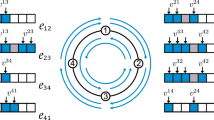Abstract
This paper deals with the problem of optimal dynamic routing in WDM optical networks with wavelength-changing facilities available at some of the nodes. The route may be either a lightpath (i.e., wavelength continuous channel) or a semi-lightpath (i.e., wavelength-converted channel). We attempt to estimate in this work the gain in blocking probability, when we move from lightpath routing to semi-lightpath routing, keeping the number of wavelengths fixed, in a given circuit switched network. We ensure optimal (minimum cost) routing in both the cases by using the algorithm of Banerjee et al. [7,8] (called Algorithm-I in this paper) for lightpaths and that of Chlamtac et al. [6] (called Algorithm-II) for semi-lightpaths. Our results indicate that, for both the algorithms, the blocking probability (P B), as expected, increases with network load. At light load, P B for Algorithm-I is always larger than that for Algorithm-II. But the rate of increase in P B is slightly higher in case of Algorithm-II, so that there is a crossover point where P B for Algorithm-II exceeds P B for Algorithm-I. This probably happens due to the irregularities in the semi-lightpaths at heavy loads when almost all routes are exhausted in the network. However, since this crossover phenomenon occurs at a very congested status of the network, it has little significance over the real life operation of a network. It only suffices to indicate that, under heavy load, both the algorithms are equally insufficient, and conversion does not improve the situation as might have been expected intuitively.
Similar content being viewed by others
References
B. Mukherjee, et al., Some Principles for Designing a Wide-Area Optical network, IEEE/ACM Trans. Networking, vol. 4, no. 5, (October 1996), pp. 684–695.
C. A. Brackett, Dense Wavelength Division Network, IEEE Journal on Selected Areas of Communication, vol. 8, no. 6, (August 1990), pp. 948–958.
R. Ramaswami, K. N. Shivarajan, Routing And Wavelength Assignment in All Optical Networks, IEEE/ACM Transaction on Networking, vol. 3, no. 3, (October 1995), pp. 489–500.
R. Ramaswami, K. N. Shivarajan, Design of Logical Topologies For Wavelength Routed Optical Networks, IEEE Journal on Selected Areas in Communication, vol. 14, no. 5, (June 1996), pp. 840–851.
D. Banerjee, B. Mukherjee, A Practical Approach for Routing and Wavelength Assignment in large Wavelength Routed Optimal Networks, IEEE Journal on Selected Areas in Communication, vol. 14, no. 5, (June 1996), pp. 903–908.
I. Chlamtac et al., Lightpath (wavelength) routing in large WDM networks, IEEE Journal on Selected Areas in Communication, vol. 14, no. 5, (June 1996), pp. 909–913.
S. Banerjee, C. Chen, Design of Wavelength-Routed Optical Networks for Packet Switched Traffic, Proc. IEEE ICC'96, (Dallas, June 1996), pp. 444–448.
S. Banerjee, C. Chen, Design of Wavelength-Routed Optical Networks for Circuit Switched Traffic, Proc. IEEE Globecom '96, (London, November 1996).
D. Saha et al., An approach to wide area WDM optical network design using genetic algorithm, Computer Communication, vol. 22, (Jan 1999), pp. 156–172.
D. Saha, Performance analysis of the effect of alternative (shorter) lightpaths on the design of wavelength-routed optical networks, Proc. IEEE TENCON'99, (Cheju, Korea, Sept. 1999).
D. Saha, Virtual topolgy design in all-optical networks using independent sets and genetic algorithm, Proc. Int'l Conf. on Fibre Optics and Photonics (PHOTONICS-98), (IIT Delhi, India, Dec. 1998), pp. 927–930.
A. Birman, Computing approximate blocking probabilities for a class of all-optical networks, Proc. IEEE INFOCOM'95, (1995).
Author information
Authors and Affiliations
Rights and permissions
About this article
Cite this article
Saha, D. Lightpath Versus Semi-Lightpath: Some Studies on Optimal Routing in WDM Optical Networks. Photonic Network Communications 2, 155–161 (2000). https://doi.org/10.1023/A:1010036422970
Issue Date:
DOI: https://doi.org/10.1023/A:1010036422970




